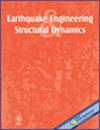This paper presents an experimental study that examined the role of the slab continuity and framing action on the overall hysteretic behavior of a composite-steel moment resisting frame (MRF) up until incipient collapse using advanced instrumentation. The test frame was subjected to three loading phases including asymmetric cyclic lateral loading representative of ratcheting prior to earthquake-induced collapse. It is shown that the presence of partially restrained transverse beams as part of the floor system results into additional overstrength at the beam-to-column joints due to the development of transverse compressive strains at the slab surface. The primary deteriorating mechanisms of the test frame were local buckling at the bottom flanges of the composite-steel beams followed by concrete crushing at the slab at a lateral drift demand of 3%–4%. Additional instabilities within the dissipative zones of the beams featured the crack initiation and propagation. However, the axial restraint provided by the slab and the framing action led to the stabilization of the crack growth and the local buckling straightening at the bottom flange of the beams even at lateral drift demands higher than 10% rad. This is due to the development of a compressive axial force that passed through the slab and reached up to about 35% of the axial resistance of the bare steel beam at incipient collapse. It is shown that this force prevents the beam axial shortening within the dissipative zones of the test frame, which contradicts the results from conventional beam-to-column connection tests with simplified boundary conditions. The experimental results suggest that controlled slip in the ductile shear studs in shallow composite-steel beams act as a capping mechanism of the additional strain demands that may arise due to the potential overstrength on the concrete compressive strength from its assumed characteristic value, the slab confinement, and the presence of the transverse beams. Composite-steel beams under hogging bending were able to sustain about 50% of their peak flexural resistance even at chord rotations exceeding 15% rad due to the stabilization of the local buckling length within the dissipative zone. On the other hand, composite-steel beams under sagging bending attained a zero flexural resistance at the same rotational demands while not achieving a complete separation due to the developed cracks. Measurements from a digital image correlation system suggest that the strut inclination at the interior joint was about 30% higher than that suggested by current standards due to the slab continuity.


